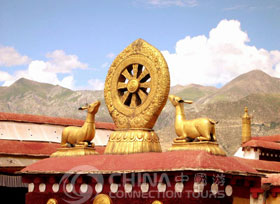 Shigatse connects with Nepal, Bhutan and Sikkim in the south, Ngari in the west, Nagqu in the north and Lhasa and Shannan in the east. It occupies an area of 176,000 square kilometers. It is 800 kilometers from east to west and 220 kilometers from north to south, with a border of 1,354 kilometers.
Shigatse connects with Nepal, Bhutan and Sikkim in the south, Ngari in the west, Nagqu in the north and Lhasa and Shannan in the east. It occupies an area of 176,000 square kilometers. It is 800 kilometers from east to west and 220 kilometers from north to south, with a border of 1,354 kilometers.
Historically, Shigatse was called Tsang, which was an important administrative district in Tibet. During the reign of the Tubo Kingdom, the ruling class divided the kingdom’s central part into two divisions, Wei and Tsang, along geographic lines. Tsang, with Shigatse as its center, was again divided into Yeru (the present-day Nyang Qu River area) and Rulha (the present-day upper reaches of the Yarlung Zangbo River). The area extends to Gamba La Mountains in the east and Kangdese Mountains in the west. Because Tsang was located mostly along the upper Yarlung Zangbo River, it was also called Houtsang, a name still used today.
In the 13th century, the Yuan Dynasty divided Tibet into thirteen 10,000 household units. Shigatse had six such units: the Qoimai, Xalhu, Jigmei, Lhadoiqain, Lhadoilho and Xangba. During the reign of the Pagmo Zhuba Kingdom, this organizational system was abolished and replaced with 13 zongs (counties). Counties within Shigatse are Rinbung, Shigatse, Bainang and Gyangze. Early in the last century, the Tibetan government promoted Shigatse to the level of gyizong (district), which had under its jurisdiction 16 counties and 30 or so independent shikas (manors). After 1951, two branch Working Committees were established in Shigatse and Gyangze, respectively. In 1956, an administrative office at the district level was established.
Population
The population of 609,228 in 1997 included 554,704, farmers and herdsmen (about 9 % of the population). Tibetans accounted for 97 percent of the population, and the other 3 percent was Han Chinese and the other 15 ethnic groups, such as Hui, Monggol, Tu, Manchu, Miao and Zhuang. There were 1,875 Xia'erba people. The population in Shigatse accounts for one-fourth of the population in the Tibet Autonomous Region, and the population density is 3.3 people per square kilometer. Most of the people live in the Yarlung Zangbo River area. The western pastoral area is sparsely populated.
Shigatse is located mostly between the middle of the Himalayan and the middle of the Kangdese-Nyainqentanglha mountain ranges. The southern and northern terrains are high, while the South Tibet Plateau and the Yarlung Zangbo River constitute the low-lying middle area. Formed basically of high mountains, wide valleys, lakes and basins, this land has a varied topography with an average elevation of more than 4,000 meters.
The Himalayas, which stretch across southern Shigatse, is the youngest and highest mountain range in the world, with an average elevation of more than 6,000 meters. In that area, five peaks are more than 8,000 meters high namely, Mount Qomolangma (Everest) 8,848.13 meters, Mount Lhoze (8,516 meters), Mount Kab (8,463 meters), Mount Qowowuyag (8,201 meters) and Mount Xixabangma (8,012 meters). Mount Qomolangma, located on the border between Shigatse and Nepal, is the world's highest peak, the roof of the world. In addition there are 14 peaks that stand more than 7,000 meters above sea level. Besides those mentioned above are Karru La, Gyaco La, Ma La, Zom La, Lhagyi and Mari La. All these mountains provide spectacular natural scenery for sightseeing, exploring and conducting scientific investigations.
The upper southern Tibetan basin along the Yarlung Zangbo and Nyang Qu rivers is the largest grain producing area in Shigatse. It consists of the densely populated Larze-Rinbung Valley and Gyangze-Shigatse Plain. Other plains include the Penqoi River Valley on the southern Tibet Plateau at the northern foot of the Himalayas and some sparsely scattered small river valleys. These plains sprawl on gentle slopes, with thick soil, temperate climate and plentiful water. With natural conditions suitable for growing crops, they form the major farming areas in Shigatse.

